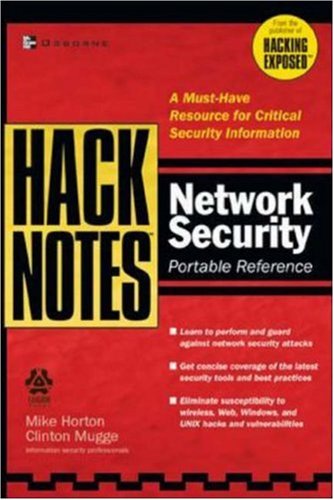Michael Horton0-07-222783-4
Table of contents :
Team DDU……Page 1
CONTENTS……Page 12
Acknowledgments……Page 18
HackNotes: The Series……Page 20
Introduction……Page 24
Reference Center……Page 28
Windows System and Network Commands……Page 29
Windows Enumeration Commands and Tools……Page 30
Common DOS Commands……Page 32
UNIX System and Network Commands……Page 33
Specific UNIX Enumeration Commands……Page 36
Netcat Remote Shell Commands……Page 37
Router Commands……Page 38
Usable Hosts and Networks……Page 39
Password and Log File Locations……Page 40
Most Useful Ports and Services in the Hacking Process……Page 41
Common Remote-Access Trojans and Ports……Page 43
Common Trojan Ports……Page 44
Dangerous File Attachments “Drop List”……Page 45
Common and Default Passwords……Page 47
Decimal, Hex, Binary, ASCII Conversion Table……Page 48
Windows and UNIX Hacking Steps……Page 51
Must-Have Free (or Low Cost) Tools……Page 56
Part I Network Security Principles and Methodologies……Page 60
■ 1 Security Principles and Components……Page 62
ARBIL Outer Wheel……Page 63
ARBIL Inner Wheel……Page 65
Confidentiality……Page 66
A Glimpse at the Hacking Process……Page 67
Information Security Threats List……Page 68
Vulnerability List……Page 69
Network Security Safeguards and Best Practices……Page 71
Network Security Best Practices……Page 72
Summary……Page 75
■ 2 INFOSEC Risk Assessment and Management……Page 76
Risk Management Using the SMIRA Process……Page 77
What Is Risk Assessment?……Page 80
Risk Assessment Components……Page 82
Asset……Page 85
Threat Agent/Actor and Threat Act……Page 87
Vulnerability……Page 88
Safeguards and Controls……Page 89
Conducting a Risk Assessment……Page 91
Summary……Page 93
Part II Hacking Techniques and Defenses……Page 94
■ 3 Hacking Concepts……Page 96
Reconnaissance……Page 97
Compromise……Page 100
Leverage……Page 101
Targeting List……Page 102
Attack Trees……Page 103
Infrastructure……Page 104
Application……Page 105
Summary……Page 106
■ 4 Reconnaissance……Page 108
Identification of the Enterprise……Page 109
Identification of Addresses……Page 110
Scan……Page 111
DNS Discovery……Page 112
ICMP Scan……Page 113
TCP Scan……Page 114
UDP Scan……Page 115
Services Enumeration……Page 116
Advanced Stack Enumeration……Page 120
Source Port Scanning……Page 121
Service Enumeration……Page 122
Banner Nudges……Page 128
Client Connections……Page 129
Summary……Page 130
■ 5 Attack, Compromise, and Escalate……Page 132
UNIX Exploits……Page 133
Remote UNIX Attacks……Page 134
Remote Attacks on Insecure Services……Page 137
Local UNIX Attacks……Page 143
Remote Attacks-Windows 9x/ME……Page 146
Local Attacks-Windows 9x/ME……Page 148
Windows NT/2000……Page 149
Remote Attacks-Windows NT/2000……Page 150
Local Attacks-Windows……Page 153
Native Application Attacks-Windows NT/2000……Page 158
Summary……Page 163
Part III Special Topics……Page 164
■ 6 Wireless Network Security……Page 166
Overview of 802.11 Wireless Standards……Page 167
Attacking the Wireless Arena……Page 169
The Future of 802.11 Security……Page 176
Summary……Page 177
■ 7 Web Application Security……Page 178
Beyond Firewalls……Page 179
Securing the Servers and Their Environments……Page 180
Categories of Web Application Security……Page 182
Authentication……Page 183
Authorization……Page 184
Session Management……Page 186
Input Parameters……Page 187
Encryption……Page 190
Miscellaneous……Page 191
General Web Application Assessment/Hacking……Page 193
Methodology……Page 194
Summary……Page 198
■ 8 Common Intruder Tactics……Page 200
Social Engineering……Page 201
They Seem Legitimate!……Page 203
Network Sniffing-What Are Sniffers?……Page 206
Commonly Used Sniffers……Page 207
How Do You Detect Sniffers?……Page 212
Exploiting Software Design and Implementation Flaws……Page 216
Buffers-What Are They?……Page 217
Developing the Exploit Code……Page 221
War Dialing and PBX Hacking……Page 222
Overview of Security Implications……Page 223
Types of Dial-Up Systems to Protect……Page 224
Top Three War Dialing Tools……Page 232
Summary……Page 234
■ 9 Incident Response……Page 236
Trojan Horse Programs……Page 237
Rootkits……Page 239
Identifying a Compromise……Page 240
User Accounts and User Groups……Page 241
File Systems/Volumes and Processes……Page 243
Logging……Page 245
Stage One: Identify and Disable……Page 246
Stage Three: Implement Countermeasures and Heighten Awareness……Page 247
Stage Four: Recover and Rebuild……Page 248
Stage Five: Wrap Up and Analyze……Page 249
Summary……Page 250
■ 10 Security Assessment/Hardening Checklists……Page 252
System Assessment and Hardening Concepts……Page 253
Checklists……Page 255
Microsoft Windows……Page 256
UNIX……Page 258
Web Server……Page 262
FTP Service……Page 264
Mail……Page 265
Router……Page 266
Wired Network……Page 268
Wireless Network……Page 270
Physical Security……Page 271
Summary……Page 274
■ Appendix: Web Resources……Page 276
Various Security News and Informational Sites……Page 277
Default Password Lists……Page 278
Education/Certification/Organizations……Page 279
Government Affiliated……Page 280
Miscellaneous Interesting Items……Page 281
■ Index……Page 282

Reviews
There are no reviews yet.